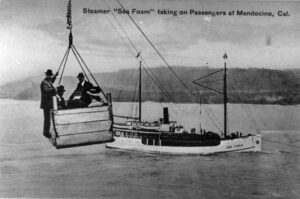As a historian, it is easy to be researching one project and get waylaid by interesting materials that have nothing to do with the research topic at hand. The book “Caspar Notebook – School Days” by Ann M. Connor, self-published in 1979, was half about the topic I was after (schools) but the rest was stuffed with tidbits of Caspar history from 1895 to 1905 that I share here.

Connor must have spent a long time going through old Mendocino Beacon newspapers gleaning every bit of news that mentioned Caspar. Much of what she recorded was hum-drum stuff, like who was visiting whom, who was traveling where, births, deaths, marriages, accidents, lodge meetings, ballgames, and mill and woods news. What I found interesting were the odd little insights into the life of the town and its inhabitants.
In 1895 the Caspar Lumber Company (CLC) shipped 12,153,534 board feet (bf) of lumber, surpassing Albion Lumber Company’s 12,097,393 bf and Mendocino Lumber Company’s 11,200,000 bf.
In April of 1896 A. L. Fisher, the “jolly tombstone man” was visiting from Santa Rosa. In September of that year CLC lost a valuable horse pulling a load of lumber and other supplies. It was assumed the horse died of heart disease. How do you diagnose heart disease in a dead horse?
“A tribe of filthy gypsies which have been infesting the neighborhood were ordered to move on by the sheriff and they left northward. Property owners along the way should check their chicken roosts for missing stock,” the Beacon reported in December 1896.
In June of the next year, when CLC’s schooner “Elvina” was wrecked at Caspar, clever workman filled her hold with empty, sealed barrels to keep her afloat as she was towed to San Francisco.
In July of 1898 it was noted that CLC’s locomotive engineer W. G. Turner had lately been in the business of making leather suspenders which were satisfactory to the woodsmen.
A 48-foot whale was stranded at the mouth of Jug Handle Creek in January of 1901. In May of that year the passing of a Caspar housewife resulted in her internment in the “Silent City of the Dead” in Fort Bragg.
September saw the wedding of Anna Jefferson and Henry Stuart Tregoning. Her wedding dress was described in glowing details for a paragraph, but the groom was clothed in a “conventional wedding suit.”
A Masquerade Ball in the fall noted every costume worn by every guest, all 40 of them. While we might recognize conventional costume choices like soldier, sailor, clown, hoodlum and Mexican señorita, some folks came dressed as the Queen of Clubs, Evening Star, Little Red Riding Hood, Goddess of Liberty, and a “Natural Curiosity,” whatever that was.
In July 1902 workmen were agitating for a 10-hour workday, and in September of 1903 schools were closed for a measles epidemic.
Mrs. Abbie Krebs, president of the CLC, caused excitement in April of 1904 when she hired a “moving pictures” expert to photograph the manufacture of redwood lumber. It began with cutting the tree down, hauling the log with steam donkeys to the rail line, pulling it to the mill, and the whole saw milling process. This movie was to be shown in the Forestry Building of the 1904 Louisiana Purchase Exposition in Saint Louis to educate viewers on why they should choose this lumber for building homes. The roof of the Caspar Mill was partially removed to get enough light in for filming the sawing operation. (On page 66 of Ted Wurm’s book, “Mallets on the Mendocino Coast,” you can see a photo of the mill minus its roof).
Five thousand boxes of apples from the CLC’s expansive orchards four miles east of town were harvested by November of 1904. What was not used in the mill’s dining halls and local lumber camps was shipped south. “Best grades were wrapped individually in tissue paper and make a very handsome appearance and command a fancy price.” In 1905 eggs were 12 cents a dozen, butter was 18 cents a pound and coffee 15 cents a pound.
That same year the phone system in Caspar was modernized with two operators working 7 a.m. to 10 p.m. A new line extended from Hardy Creek to Rockport (between lumber mills and shipping points) and a new line was planned from Fort Bragg to Ukiah. Before then, a call was forwarded to Gualala, then on to Santa Rosa and back up to Ukiah and gave unsatisfactory service.
Passengers aboard the steamer “Sea Foam” in 1905 were charged $4.00 for a cabin and a meal if you left San Francisco at 4 p.m. on Wednesday, touching briefly at Point Arena and arriving in Mendocino Thursday morning. If you preferred stagecoach and train, a four-horse stage left Mendocino at 4:30 a.m. and arrived in Ukiah at 12:15 p.m. in time to catch the train to San Francisco the same day for $7.00.
Ann Connor’s writing about the Caspar schools will be featured in a future story. In 1969 she had written “Caspar Calling” about the earlier years in town and she also wrote “Golden Years in Caspar – 1878 to 1895.” All these now out-of-print books have extensive alphabetical indexes of the last name of every person mentioned in the book which is a true gift to researchers and genealogists. You can find the books and the indices, as well as the CLC movie, in the archives of local museums, including the Kelley House Museum in Mendocino. Contact [email protected]